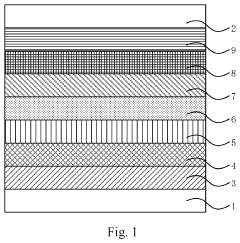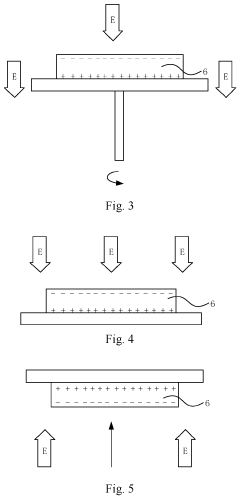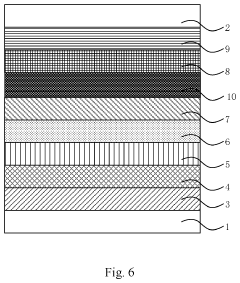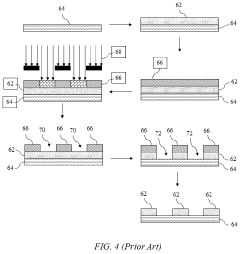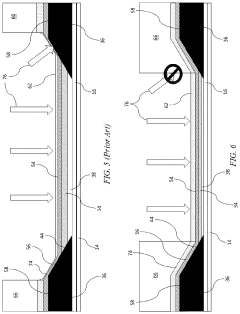QLED Displays as Tools for Education and Visual Learning
QLED Display Evolution
QLED display technology has undergone significant evolution since its inception, marking a transformative journey in the field of visual display systems. The development of QLED displays can be traced back to the early 2000s when researchers began exploring the potential of quantum dots in display applications. These nanoscale semiconductor particles exhibited unique optical properties, capable of emitting light with high color purity and efficiency.
The first major milestone in QLED evolution came with the successful integration of quantum dots into LED backlighting systems. This innovation, introduced in the mid-2010s, dramatically improved color accuracy and brightness in LCD displays. The technology quickly gained traction in the consumer electronics market, with major manufacturers incorporating quantum dot-enhanced backlights into their premium television and monitor lineups.
As research progressed, the focus shifted towards developing true QLED displays, where quantum dots would serve as the primary light-emitting elements. This approach promised even greater improvements in color reproduction, energy efficiency, and overall display performance. By the late 2010s, prototypes of electroluminescent QLED displays began to emerge, demonstrating the potential for self-emissive quantum dot technology.
The evolution of QLED displays has been marked by continuous advancements in quantum dot synthesis, deposition techniques, and device architectures. Researchers have made significant strides in improving the stability and longevity of quantum dots, addressing early concerns about degradation and color shift over time. Additionally, the development of more efficient charge transport layers and electrode materials has contributed to enhancing the overall performance of QLED devices.
In recent years, the focus has shifted towards scaling up QLED technology for mass production. This has involved overcoming challenges related to manufacturing processes, yield rates, and cost-effectiveness. Concurrently, efforts have been made to expand the color gamut and increase the peak brightness of QLED displays, pushing the boundaries of what is possible in terms of visual fidelity and dynamic range.
The evolution of QLED technology has also seen a growing emphasis on sustainability and energy efficiency. Researchers have explored ways to reduce the environmental impact of quantum dot production and improve the power consumption characteristics of QLED displays. This aligns with broader industry trends towards more eco-friendly and energy-efficient display solutions.
As QLED technology continues to mature, its potential applications in education and visual learning have become increasingly apparent. The superior color reproduction and high brightness of QLED displays make them particularly well-suited for creating immersive and engaging learning environments. The ongoing evolution of this technology promises to deliver even more advanced display solutions that can enhance the educational experience through improved visual clarity, interactivity, and adaptability to various learning contexts.
Educational Market Needs
The educational market is experiencing a significant shift towards digital and interactive learning tools, creating a growing demand for advanced display technologies like QLED (Quantum Dot Light Emitting Diode) displays. These displays offer several advantages that align well with the evolving needs of educational institutions and learners.
One of the primary market needs driving the adoption of QLED displays in education is the demand for high-quality visual content. As educational materials become increasingly complex and visually rich, there is a need for displays that can render images, videos, and interactive content with exceptional clarity and color accuracy. QLED technology, with its ability to produce vibrant colors and deep contrasts, meets this requirement effectively.
Another crucial market need is the ability to support long hours of use without causing eye strain. Educational settings often involve extended periods of screen time, making eye comfort a top priority. QLED displays, with their high brightness and low blue light emission, address this concern, potentially reducing eye fatigue and improving overall learning experiences.
The trend towards larger classroom displays is also driving the adoption of QLED technology. Schools and universities are moving away from traditional projectors and whiteboards, opting instead for large-format displays that can be easily viewed from all angles in a classroom. QLED displays, available in various sizes, cater to this need while maintaining image quality even in well-lit environments.
Energy efficiency is another key consideration in the educational market. As institutions strive to reduce operational costs and environmental impact, there is a growing demand for display technologies that consume less power. QLED displays, known for their energy efficiency compared to traditional LCD screens, align well with these sustainability goals.
The rise of remote and hybrid learning models has further accelerated the need for high-quality display technologies. Educational institutions are seeking solutions that can deliver consistent visual experiences across different devices and locations. QLED displays, with their superior color reproduction and brightness, can help ensure that visual content remains impactful whether viewed in a classroom or on a student's personal device.
Lastly, there is an increasing focus on interactive and immersive learning experiences. Educational institutions are looking for display technologies that can support touch interfaces, augmented reality (AR), and virtual reality (VR) applications. While QLED technology itself does not inherently provide these features, its superior visual quality can significantly enhance the overall experience when combined with interactive technologies.
QLED Tech Challenges
QLED (Quantum Dot Light-Emitting Diode) displays have shown great potential in the field of education and visual learning. However, several technical challenges need to be addressed to fully realize their potential in these applications.
One of the primary challenges is achieving consistent color accuracy and uniformity across the entire display. While QLED technology offers a wider color gamut compared to traditional LED displays, maintaining precise color reproduction over extended periods and across different viewing angles remains a significant hurdle. This is particularly crucial in educational settings where accurate representation of visual information is essential for effective learning.
Another challenge lies in improving the energy efficiency of QLED displays. Although they are more energy-efficient than traditional LCD displays, there is still room for improvement, especially when considering long-term use in classroom environments. Developing more efficient quantum dot materials and optimizing the overall display architecture to reduce power consumption without compromising image quality is an ongoing area of research.
Durability and lifespan of QLED displays pose additional challenges. In educational settings, displays are often subjected to frequent use and varying environmental conditions. Enhancing the stability of quantum dot materials to prevent degradation over time and improving the overall robustness of the display structure are critical areas that require further development.
The cost of QLED technology remains a significant barrier to widespread adoption in educational institutions. While prices have decreased in recent years, QLED displays are still relatively expensive compared to conventional display technologies. Developing more cost-effective manufacturing processes and materials is essential to make QLED displays more accessible for educational purposes.
Addressing the issue of blue light emission is another important challenge. QLED displays, like many other display technologies, emit blue light that can cause eye strain and potentially disrupt sleep patterns. This is particularly concerning in educational settings where students may spend extended periods interacting with displays. Developing solutions to reduce harmful blue light emissions while maintaining color accuracy and brightness is a key area of focus.
Integration of touch and interactive features with QLED displays presents additional technical hurdles. While touch functionality is crucial for interactive learning experiences, implementing it effectively without compromising display quality or increasing costs significantly is a complex task. Developing seamless touch integration solutions that are both responsive and durable is essential for educational applications.
Lastly, optimizing QLED displays for various content types used in education, such as text, images, videos, and interactive simulations, requires careful calibration and software development. Creating adaptive display technologies that can automatically adjust to different content types and lighting conditions to provide the best viewing experience for students and educators is an ongoing challenge in the field.
QLED in Education
01 Quantum dot light-emitting diode structure
QLED displays utilize a structure incorporating quantum dots as the light-emitting material. This structure typically includes layers such as a substrate, electrodes, quantum dot layer, and charge transport layers. The quantum dots are engineered to emit specific colors when excited, allowing for precise color control and high color purity in displays.- Quantum dot light-emitting diode structure: QLED displays utilize a structure incorporating quantum dots as the light-emitting material. This structure typically includes layers such as a substrate, electrodes, quantum dot layer, and charge transport layers. The quantum dots are engineered to emit specific colors when electrically excited, providing high color purity and efficiency.
- Color conversion layer using quantum dots: Some QLED display designs use quantum dots as a color conversion layer rather than direct light emitters. In this approach, blue LEDs are used as a backlight, and quantum dots convert the blue light to red and green, creating a full-color display. This method can improve color gamut and energy efficiency compared to traditional LCD displays.
- Quantum dot synthesis and composition: The performance of QLED displays heavily depends on the properties of the quantum dots used. Research focuses on developing new quantum dot compositions, improving synthesis methods, and enhancing the stability and efficiency of these nanoparticles. This includes exploring various core-shell structures and doping techniques to optimize optical properties.
- QLED display driving and control methods: Advanced driving and control methods are crucial for optimizing QLED display performance. This includes developing efficient pixel driving circuits, implementing sophisticated color management algorithms, and designing control systems to maintain display quality over time. These methods aim to enhance brightness, contrast, and color accuracy while minimizing power consumption.
- Integration of QLED technology with other display innovations: QLED technology is being integrated with other display innovations to create hybrid solutions. This includes combining QLED with OLED technology, incorporating micro-LED elements, or developing flexible and transparent QLED displays. These hybrid approaches aim to leverage the strengths of multiple technologies to achieve superior display performance and form factors.
02 Color conversion and enhancement
QLED technology employs quantum dots for color conversion and enhancement. This involves using quantum dots to convert blue or UV light from a backlight into pure red and green light. The process results in improved color gamut, brightness, and energy efficiency compared to traditional LCD displays.Expand Specific Solutions03 Quantum dot synthesis and composition
The development of QLED displays involves the synthesis of quantum dots with specific compositions and structures. This includes core-shell quantum dots, alloy quantum dots, and perovskite quantum dots. The composition and structure of these quantum dots are crucial in determining their optical and electronic properties, which directly impact display performance.Expand Specific Solutions04 QLED manufacturing processes
Manufacturing processes for QLED displays involve techniques such as solution processing, inkjet printing, and photolithography. These processes are used to deposit quantum dot layers, create patterned structures, and integrate quantum dots into display devices. Innovations in manufacturing aim to improve yield, reduce costs, and enable large-scale production of QLED displays.Expand Specific Solutions05 QLED device optimization
Optimization of QLED devices focuses on improving various aspects such as efficiency, lifetime, and color purity. This includes developing new materials for charge transport layers, optimizing device architectures, and implementing strategies to mitigate degradation mechanisms. Advanced encapsulation techniques are also employed to protect quantum dots and extend device longevity.Expand Specific Solutions
Key QLED Manufacturers
The QLED display market for education and visual learning is in a growth phase, with increasing adoption in classrooms and e-learning platforms. The market size is expanding rapidly, driven by the demand for high-quality, energy-efficient displays in educational settings. Technologically, QLED displays are maturing, with companies like Samsung Display Co., Ltd. and BOE Technology Group Co., Ltd. leading innovation. Sharp Corp. and TCL China Star Optoelectronics Technology Co., Ltd. are also making significant strides in QLED technology. Nanosys, Inc. is contributing to advancements in quantum dot materials, while Huawei Technologies Co., Ltd. is integrating QLED displays into smart education solutions. The competition is intensifying as more players enter the market, focusing on improving color accuracy, brightness, and durability for educational applications.
BOE Technology Group Co., Ltd.
Sharp Corp.
QLED Display Patents
- Incorporating ionic coordination compound layers with built-in electric fields between the hole transport layer and quantum dot luminescent layer, and between the electron transport layer and quantum dot luminescent layer, to alter vacuum energy levels and reduce potential barriers, thereby improving hole injection efficiency and balancing carriers.
- A top emitting QLED apparatus with a reflective auxiliary electrode and a transparent filler material, where the auxiliary electrode is configured to reflect internally reflected light out of the sub-pixel and the transparent filler material aids in light extraction, while a patterned low refractive index layer helps in forming an internal reflection interface to enhance light directionality, and the reflective bank structure is designed to minimize crosstalk and current leakage.
QLED vs Other Displays
QLED displays offer several advantages over other display technologies when used as tools for education and visual learning. Compared to traditional LCD displays, QLED screens provide superior color accuracy, brightness, and contrast ratios. This enhanced visual quality can significantly improve the learning experience, especially for subjects that rely heavily on visual aids such as art, biology, and geography.
One of the key benefits of QLED technology is its ability to produce a wider color gamut. This means that QLED displays can reproduce a larger range of colors more accurately than conventional displays. In educational settings, this can lead to more vivid and lifelike representations of complex concepts, making it easier for students to grasp and retain information.
QLED displays also offer better energy efficiency compared to OLED technology. While OLED screens are known for their excellent picture quality, they can suffer from burn-in issues and have shorter lifespans. QLED displays, on the other hand, are more durable and maintain their performance over longer periods, making them a more cost-effective solution for educational institutions.
In terms of brightness, QLED displays outperform both LCD and OLED technologies. This higher brightness capability is particularly beneficial in classroom environments where ambient light conditions can vary. It ensures that content remains visible and legible even in well-lit rooms, reducing eye strain for students and teachers alike.
Another advantage of QLED displays is their ability to maintain color accuracy at different viewing angles. This is crucial in classroom settings where students may be seated at various positions relative to the screen. Unlike some LCD displays that can suffer from color shifting when viewed off-center, QLED technology ensures consistent color reproduction across a wide viewing angle.
When compared to projection systems, QLED displays offer several benefits for educational use. They provide higher contrast ratios and better visibility in bright environments, eliminating the need for dimming lights or using special screens. This flexibility allows for more dynamic and interactive learning experiences, as teachers can seamlessly integrate digital content without compromising on visibility or image quality.
In conclusion, while each display technology has its strengths, QLED displays offer a compelling combination of visual quality, energy efficiency, and durability that makes them particularly well-suited for educational applications. Their ability to accurately reproduce colors, maintain brightness, and provide consistent performance over time positions QLED technology as a valuable tool for enhancing visual learning experiences in modern educational settings.
QLED Health Impacts
The potential health impacts of QLED (Quantum Dot Light-Emitting Diode) displays in educational settings are an important consideration as this technology becomes more prevalent in classrooms and learning environments. While QLED displays offer numerous benefits for visual learning, it is crucial to examine their effects on user health and well-being.
One of the primary concerns associated with QLED displays is blue light emission. Like many modern display technologies, QLEDs emit blue light, which has been linked to eye strain, fatigue, and potential disruption of circadian rhythms. However, QLED technology typically offers better control over blue light emission compared to traditional LED displays, potentially mitigating some of these risks.
Eye strain and visual fatigue are common issues associated with prolonged screen use, regardless of the display technology. QLED displays, with their high contrast ratios and vibrant colors, may help reduce eye strain by providing clearer, more easily discernible images. This could be particularly beneficial in educational settings where students spend extended periods engaging with visual content.
The impact of QLED displays on sleep patterns is another area of consideration. The blue light emitted by these displays can suppress melatonin production, potentially affecting sleep quality if used close to bedtime. However, many QLED displays now incorporate blue light filtering technologies, which can be activated during evening hours to minimize this effect.
Electromagnetic field (EMF) exposure is a concern raised with various electronic devices, including displays. While QLED displays do emit low levels of EMF, current research suggests that these levels are well within safety limits established by international standards. Nevertheless, long-term studies on the effects of prolonged exposure to QLED displays are still ongoing.
The potential for screen flickering in QLED displays is another health-related aspect to consider. While less prevalent than in older display technologies, some users may still be sensitive to imperceptible flickering, which can lead to headaches or eye discomfort. However, many modern QLED displays employ advanced technologies to minimize flickering, reducing this risk.
In terms of physical posture and ergonomics, the use of QLED displays in educational settings may impact students' posture and comfort during extended viewing periods. Proper positioning of displays and ergonomic considerations in classroom design are crucial to mitigate potential musculoskeletal issues associated with prolonged screen use.
